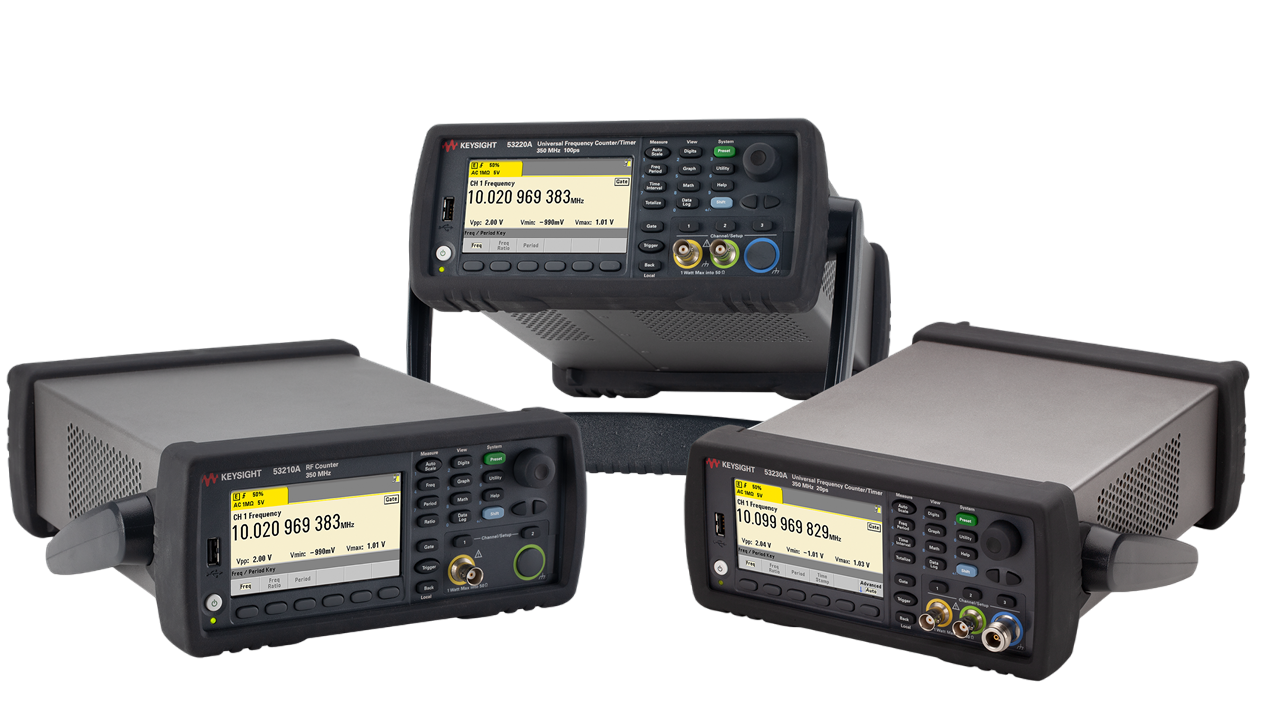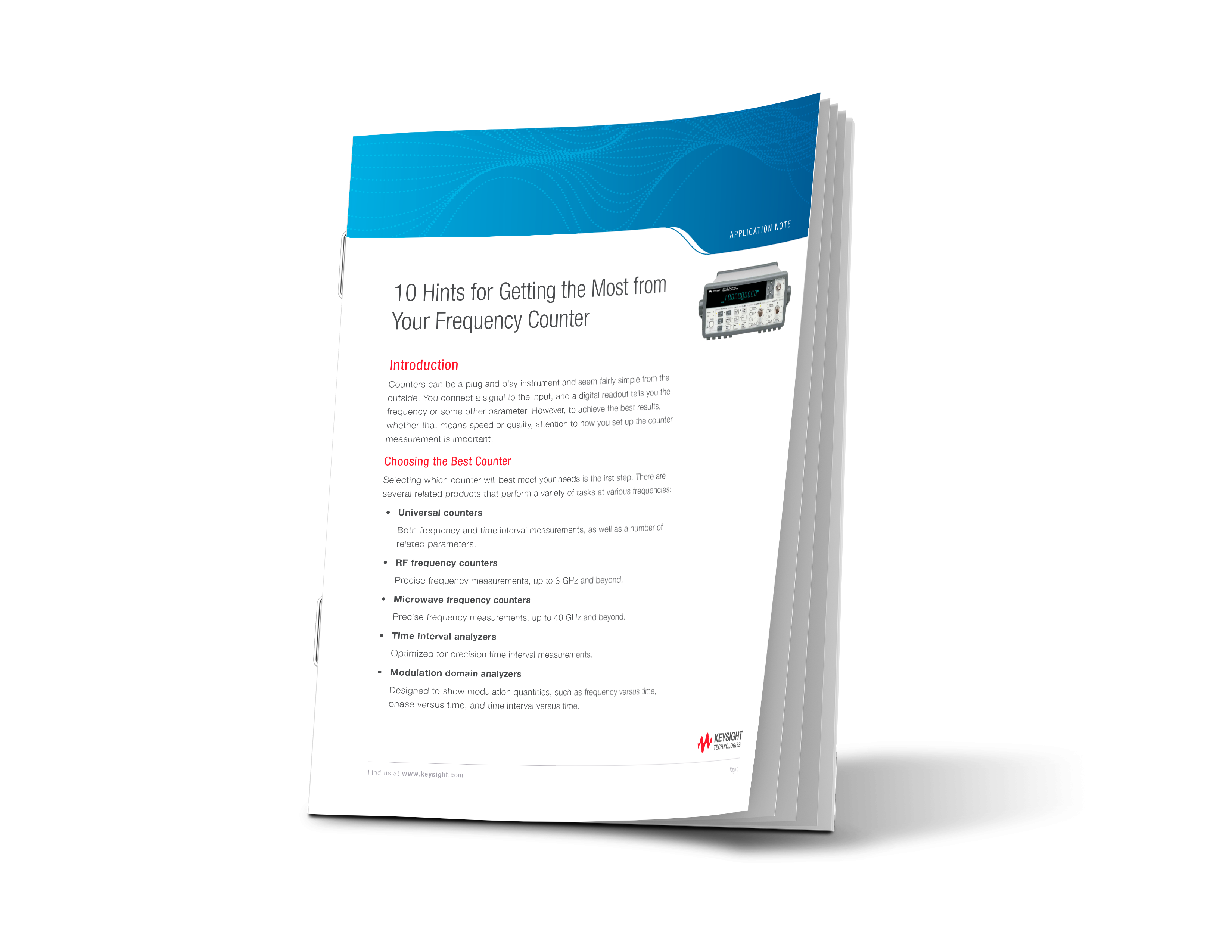What are you looking for?
53200 Series RF and Universal Frequency Counter / Timers

Highlights
The Keysight 53200 Series of 350 MHz universal and RF frequency counters / timers serve all of your frequency and time interval measurement needs. 3 available models offer resolution capabilities up to 12 digits/sec single-shot frequency resolution on a one second gate. Single-shot time interval measurements can be resolved down to 20 psec. All models in 53200 series offer new built-in analysis and graphing capabilities to maximize the insight and information you receive. Use the connectivity of your choice: LXI-C/Ethernet, USB, GPIB. Additionally, an optional battery is available to increase portability and maintain timebase accuracy.
- 53210A: 350 MHz RF Frequency Counter, 10 digit/sec
- 53220A: 350 MHz Universal Frequency Counter / Timer, 12 digit/sec, 100 ps
- 53230A: 350 MHz Universal Frequency Counter / Timer, 12 digit/sec, 20 ps
53200 Series frequency counters offer an intuitive user interface with a large color graphical display
BenchVue makes it simple to connect, control instruments, and automate test sequences.
PathWave BenchVue Universal Counter Software
Easily control your counters to build automated tests, visualize measurements, and perform data logging for faster analysis and reduced test time.
- Display measurements, charts, tables, or histograms from multiple counters simultaneously.
- Log and export data in only a few clicks to popular tools, such as MATLAB, Microsoft Excel, or Word for documentation or further analysis.
- Develop custom test procedures or sequences with Test Flow.
- Gain deeper instrument controls with Command Expert integration.
Key Specifications

Choosing the Best Frequency Counter
A frequency counter can be a plug-and-play instrument and seems fairly simple from the outside. However, to achieve the best results, attention to how you set up the frequency counter measurement is important. Our tips will help you understand the difference between resolution and accuracy, improving low-frequency measurements, and incorporating scheduled calibrations to match performance demands. Whether the goal is speed or quality these ten tips will help you use frequency counters like a pro.
Featured resources
Frequently Asked Questions – Frequency Counter
A frequency counter is a test instrument used to measure the frequency and time intervals of repetitive electronic signals. Over time frequency counters have been called many different names such as freq counters, frequency timer, rf frequency counter, and universal counter to name a few. View our Essential Guide to Frequency Counters blog to learn more uses of frequency counters.
53210A, 53220A, and 53230A are frequency counters that can operate up to 350 MHz. Upgrade options are also available for 6 GHz (option 106), and 15 GHz (option 115).
Frequency counters fall into two basic types: direct counting and reciprocal counting. Understanding the effects of the two different approaches will help you choose the best counter for your needs and use it correctly.
If your resolution requirements are flexible and you are not too concerned with speed, a direct counter is the economical choice. However, you will need a reciprocal counter for faster, higher resolution measurements. Reciprocal counters also offer continuously adjustable gate times, so you can get the resolution you need within the minimum amount of time.
The resolution of a counter is the smallest change it can detect in closely spaced frequencies. All other things equal, like measurement time and product cost, more digits are better—but the digits you see on the display need to be supported by accuracy.
The 53200 family of frequency counters offers USB LAN/LXI-C and GPIB interfaces for connecting to a computer.
The measurement accuracy of a frequency counter is strongly dependent on the stability of its time-base. The time-base establishes the reference against which the input signal is measured. The better the time-base, the more accurate the frequency counter measurements.
The quartz crystal that is the heart of every frequency counter’s time-base is a mechanical device. Since it is a mechanical device, the crystal is susceptible to physical disturbances that can change the frequency at which it vibrates which ultimately impacts the frequency counter’s accuracy. The cumulative effect of these various disturbances is known as crystal aging. It is this aging that you are compensating for when you calibrate the counter.
You can configure a modern frequency counter to make hundreds of readings per second, which can be useful for characterizing a signal that changes over time. Remember though that frequency counters are optimized for measuring a stable or slowly changing signal. Therefore, to make accurate readings, it is better to make a single good reading than trying to average many different readings.
Keysight offers both portable handheld frequency counters suitable for field use and benchtop models designed for laboratory and stationary applications.
Want help or have questions?


